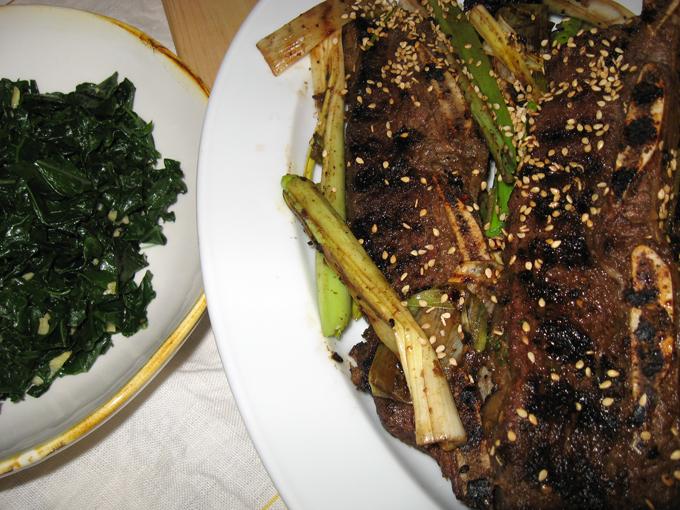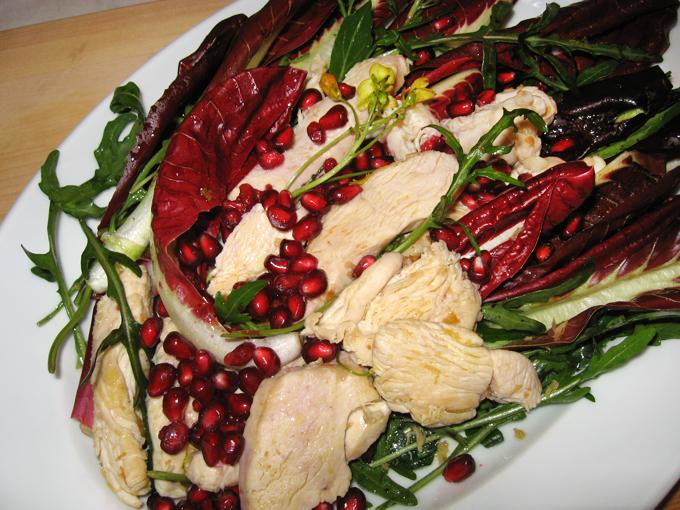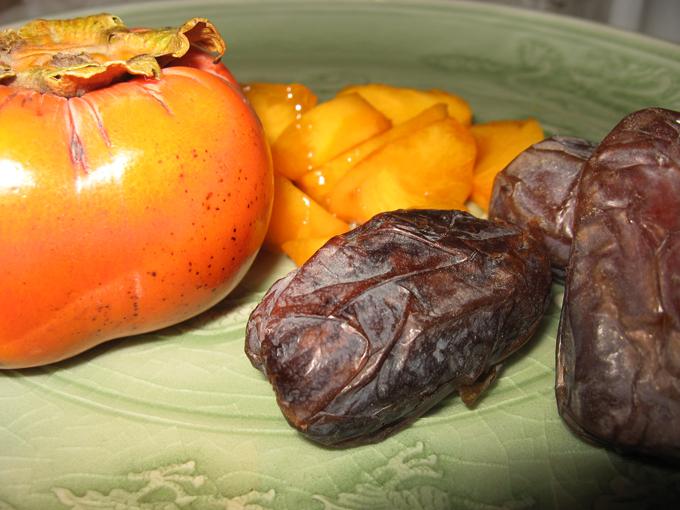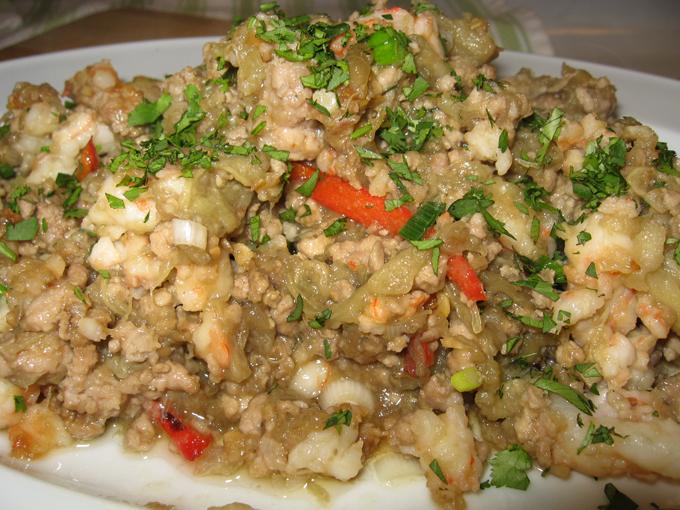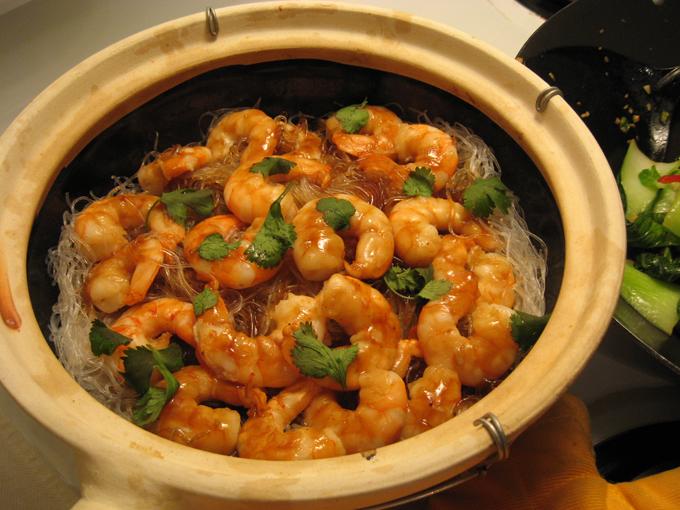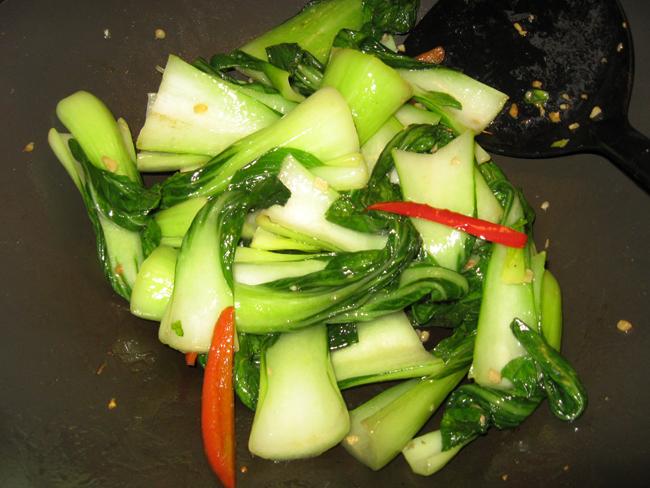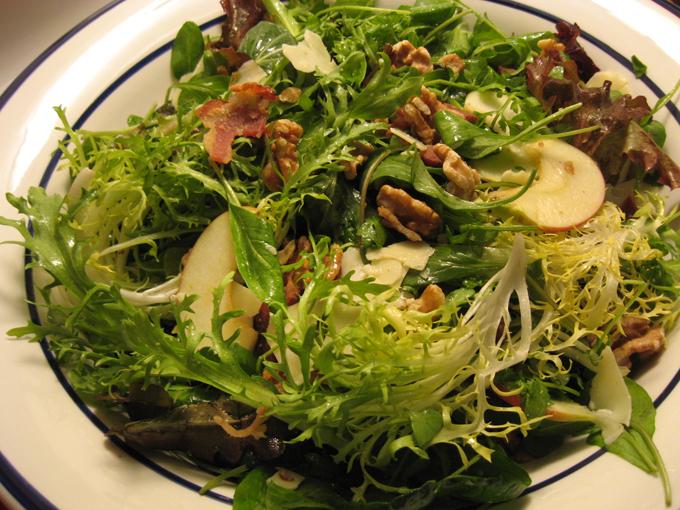-
Posts
1,729 -
Joined
-
Last visited
Content Type
Profiles
Forums
Store
Help Articles
Everything posted by djyee100
-
mm84321, lovely food. In the Langoustine dish, what is the grated stuff at the left of the plate? Welcome, Justin Uy. Your dinner looks like good comfort food. ChrisTaylor, I don't see spit-roasted duck that often. Thumbs up for your first effort. Korean-style Grilled Beef Ribs and Leeks (Bulgalbi). The beef was cut flanken-style across the bone, and marinated overnight with garlic, gingerroot, scallions, soy sauce, rice wine, sesame seeds, and chile pepper. No outdoor grill, so I pan-grilled the meat on the stovetop with some baby leeks from my CSA. A side dish of kale (also from my CSA) sauteed with garlic and fresh gingerroot. I blanched the kale before sauteing it, so that the kale would be tender. The recipe says to have the rib strips cut at 3/8" thick. That's really the ideal cut, since beef ribs can be chewy if they're thicker. I learned this the hard way when I ordered the meat from the butcher, and my meat was closer to an inch rather than a 1/2 inch. I forgot to say! Oh well. The meat tasted very good when grilled with the marinade. In this recipe I used 1 TB grated fresh gingerroot (instead of minced), regular soy sauce (instead of Japanese soy sauce), rice wine instead of dry sherry, and 1 fresh chopped cayenne chile pepper instead of red pepper flakes. The original recipe is available online here: http://www.cooking.com/Recipes-and-More/recipes/Grilled-Beef-Ribs-and-Leeks-recipe-109.aspx
-
Kim, glad to hear from you and to see pix of your appetizing dinners. And your TG sidedish of roasted onions sounds so good. Here, a dinner salad of treviso radicchio, wild arugula, sauteed chicken breast strips, and pomegranate seeds. The dressing was a sherry-balsamic vinaigrette. After sauteing the chicken strips, I deglazed the pan with some extra vinaigrette and doused the chicken with the sauce. What I liked most about this salad: the sweet-tart pomegranate seeds. I'll have to try pomegranate in more dishes now that the fruit is in season. A dessert of fuyu persimmons, and some medjool dates from the Coachella Valley. More dates, and a large variety of dates, are showing up at the farmers' market. The season for Coachella Valley dates seems to be peaking now.
-
Or, think about a salsa. Durian has a rich tropical fruit flavor. Maybe look at some mango salsa recipes and substitute durian (cut in small cubes) for the mango in a salsa. You may have to bump up the acidity with some citrus juice.
-
If you continue your experiments, I suggest that you consider the creamy avocado texture of a good durian and play with that aspect of the fruit. Salads come to mind, and the garnish on some savory dishes, including soups. If you have a chance, let us know how it goes.
-
For one or two cups of coffee in the AM, I use a manual drip maker (a Melitta) with a cone-shaped gold filter. I was told by a coffee expert that this kind of coffee is similar to that of a French press. It is, however, easier to make and easier to clean than a French press, and the gold filter is an economical buy over time. My gold filters last for years, and I clean them in the dishwasher. I set up the pot in a pan of hot water on the stovetop to keep the coffee very hot, the way I like it. Yes, this is a low-tech way to go, and my friends have given me funny looks until they taste my coffee and like it. I do spend money on high-quality coffee, Peet's Arabian Mocha Java and Major Dickinson blends, and that makes a difference, too. I set up this system a long time ago and haven't revisited my decision since. Way back when I tried a French press, I cracked it within three days. I was told to avoid electric drip makers because they require more water for a good extraction (in fact, the bigger the pot the better). With a manual maker, you can first soak the grounds, then pour in the rest of the water for a good brew in small amounts. I used to grind my coffee fresh every AM in a burr grinder. I did this for years. Then one day I said the h--l with it, it's too much work first thing in the morning, and I hate the sound of that grinder when I'm half asleep. So now I use pre-ground coffee. To be honest, I'm such a zombie in the AM that anything hot, strong, and coffee-like will do it for me. You may be more discriminating. good luck with your coffee quest!
-
If you have a little leftover peel after the stollen...I remembered this one when I was flipping thru some old pix on my computer. Panforte Ice Cream, from David Lebovitz's The Perfect Scoop. Candied citrus peel, cinnamon, cloves, honey, nutmeg, almonds. This blog has an adapted recipe. I reduced the cloves to 1/8 tsp (I'm not fond of cloves). Here: http://www.houseboateats.com/2009/12/december-flavored-ice-cream.html I should make this one for the holidays myself.
-
Wonderful meals, everyone. Dejah! That seafood stew has me drooling! Yesterday, one of my favorite easy-day dinners, Baked Chicken with Potatoes, Tomatoes, and Hot Pepper (Pollo alla Calabrese), from Rosetta Costantino's My Calabria. I've posted about this dish upthread. This time I tossed in some marinated artichokes and kalamata olives. Thumbs up for the olives, thumbs down for the marinated artichokes (too much acidity when combined with tomatoes). Fresh cooked artichokes would taste good, though. The original recipe is here: http://napavalleyregister.com/lifestyles/food-and-cooking/recipes/pollo-alla-calabrese-baked-chicken-with-potatoes-tomatoes-and-hot/article_1d170f8a-3322-11e0-bf7b-001cc4c002e0.html
-
I once made some candied Buddha's Hand citron. Once. The lovely shape is not the easiest nor the most reasonable thing you can cut up. Offhand, I can't think of other uses for this fruit. It is all peel. Using it only for zest, when other cheaper citrus will do, seems like a waste. I've advised people to candy this fruit, or use it as a centerpiece--otherwise, forget it. About candied Buddha's Hand citron on Lebovitz's blog: http://www.davidlebovitz.com/2011/02/candied-citron-recipe/ If you're ambitious, you can try to candy the entire fruit for a spectacular presentation. Other whole fruit, even whole pumpkins, are candied by this method in Southern France. The fruit is boiled in a simple syrup, laid out to dry at room temp, boiled in simple syrup again. The process continues until the entire fruit is candied. About fruit confit: http://www.davidlebovitz.com/2011/02/making-glazed-candied-fruit-citron-recipe/ http://www.europeupclose.com/article/fruit-confit-at-confiserie-florian-near-nice-france/
-
One of the best desserts I ever ate at a restaurant: A compote of candied citrus peel, along with poached fresh and dried winter fruits in simple syrup, served over little scoops of very sweet sorbets. Very colorful and beautiful with the fruits shining like jewels. I remember poached fresh kumquats in the compote. The bitterness of the peels and kumquats set off the sorbets, and made this dessert special.
-
Wok-braised Eggplant with Chopped Pork and Shrimp (Cha Traop Dot). The recipe is labelled as Cambodian, but I've seen versions of this dish from other parts of SE Asia, including Thailand. It's a stirfry of ground pork, chopped shrimp, garlic, and chiles, with a seasoning of fish sauce and sugar. At the end of cooking time, you toss in some roasted eggplant that melts into the sauce, making it creamy. This dish always says SE Asian comfort food to me. To make Wok-braised Eggplant with Chopped Pork and Shrimp (Cha Traop Dot): Puncture with a fork 4 Asian eggplants or 1 globe eggplant (1 1/2 lbs of eggplant), and broil or grill until the skin is blackened all over. Place the hot eggplants in a sealed paper bag so that the steam loosens the skin. Let cool, then peel the flesh from the skin. Cut the flesh into 2" pieces and set aside. Heat 3 TB peanut oil in a wok over high heat. Toss in 4 chopped cloves of garlic, followed by 1-2 Fresno or serrano chiles, slivered. When the garlic is lightly golden, add in 1/2 lb ground pork, breaking up any clumps. Cook until the meat loses its red color, but is still bright pink. Then toss in 1/2 lb chopped raw shrimp and the eggplant. Sprinkle on 2 TB fish sauce and 1 TB sugar, and combine. Let cook until the shrimp is almost done. Stir in 2 scallions, thinly sliced. Taste and adjust for seasoning. Garnish with chopped cilantro, and serve immediately over steamed rice. My variation of the recipe in Joyce Jue's Savoring Southeast Asia.
-
Dakki, the dish would taste good with a fruity chile or two. I was tempted to add a chile pepper myself, but the bok choy side dish had chiles in it, and enough was enough! Panaderia Canadiense, your pinchos dinner is my kind of food. I liked the medallions of turkey breast dinner you posted upthread, too. I have some Spanish paprika lying around in my cupboard, so I want to try those paprika potatoes.
-
Mjx, congrats on a fine dinner. Norm Matthews, the cabbage rolls sound like just the thing for cold weather. A Thai dinner here, Prawns and Bean Thread in Clay Pot (Gkoong Ohb Woon Sen). The noodles cook over bacon, cilantro, ginger, garlic, and black pepper, with juices from the shrimp trickling down into the mix. Fish sauce, semisweet soy sauce, and oyster sauce all go into the pot too. For a side dish, stirfried bok choy with garlic and red jalapeno chile. This blog has an adapted recipe for the Prawns and Bean Thread in Clay Pot (same ingredients, different instructions). http://mindfulmeals.wordpress.com/2010/08/07/gkoong-obb-woon-sen/ When I cook this dish, I line the bottom of the claypot with bacon strips. I decrease the garlic to 5 cloves, decrease the peppercorns to 1 tsp, and decrease the oyster sauce to 3 TB. I like this dish spicy and well-seasoned, but not as much as in the original recipe. I usually like more noodles, so I add them along with more liquid in the pot. For stock I use diluted chicken stock.
-
The pink tube shows up with the digestive tract/dark vein that we're familiar with. It shows up above the dark vein, closer to the top of the shrimp (as opposed to its underside with the legs, if I'm making any sense.) So the pink tube is something else. I thought it might be shrimp roe at first, but a search on the web said shrimp roe would be located either at the head-body joint, or by the legs. The pink tube is located elsewhere. Also, it doesn't look like any roe I've seen. No eggs, not a bright color.
-
I've seen the "pink tube" in wild-caught Gulf prawns. Dunno what it is. It looks almost fatty, a yellowish-pink color. At first I cleaned it out, but then the task became onerous so I stopped. The shrimp tasted fine and I'm still here. Depending on what I'm cooking, or how pressed I am for time, I may or may not devein shrimp. The vein is only the digestive tract, and it contains algae. Yes, it looks gross when you pull it out. But it won't harm you. The only drawback--sometimes the vein will contain grit, and that's unpleasant to chew.
-
This EGullet thread talked about red-cooked pork.
-
Prawncrackers, Nguyen says that it's possible to take the sauce too far, so that it burns to "a bitter black stage." Do you think that's true? Nguyen's sauce is supposed to be bitter, but with sweet undertones. patrickamory, don't keep us in suspense! What's the cheese?
-
The recipe may sound complicated because Nguyen is giving you a blow by blow account of what happens in the cooking process. But the caramel sauce is actually very simple. You're mixing a simple syrup of sugar and water and letting it burn to a certain point. Believe me, I've accidentally burned caramel when prepping desserts, and it's easy to do. I encourage you to give the sauce a try. When I make Vietnamese caramel sauce, I fill a stainless steel bowl with ice water and keep that in the sink. It's there to cool down the sauce when you want to stop the cooking action. Just make sure it will fit your pan comfortably. I start the sugar-water mixture on high heat until it boils. Then I lower the heat to medium and let it simmer. When the mixture begins to smoke, that's when I watch it carefully. You want the caramel to darken to the point that it looks like black coffee with a reddish cast to it. I'll even move the pan off the burner to get it under better light--once I see that black coffee/reddish cast look, the sauce is done. I pop the pan into the icewater bath, and add the last of the water to the mixture. Ta da. It's done. A jar of this sauce will keep indefinitely at room temp in the pantry. And for dinner here-- A winter salad of greens (mesclun, arugula, frisee), thin apple slices, bacon, shavings of sharp cheddar, and toasted walnuts. For the dressing, a white wine vinaigrette. This was a good combo, I'd make it again.
-
The Mycological Society of San Francisco is pretty active. They arrange dinners for their members and also do demos, etc, to educate the general public. Off the top of my head, that's the only foraging group I can think of. If you contact them, they may be able to point you to mycological or other foraging groups in your area. For some reason, I think of Slow Food as involved with foraging. You can contact your nearest local chapter. Again, these people may be able to point you to others who share your interests or who can answer your questions.
-
The Ahwahnee Hotel in Yosemite hosts cooking classes in the winter. The classes are taught by prominent chefs. Those classes are expensive, and for vacationers. However, the program may need some help with the classes (paid or otherwise), and you could check into that. Ideally, you might find some way to attend the classes, assist the chefs, whatever, without paying for the classes. I don't think enrolling in these recreational classes is for you. The Sierra foothills area is burgeoning with some fine wineries that have people sitting up and taking notice. I suggest you connect with the winemakers there. Where there are good winemakers, there are good cooks hanging around. You could learn from them, and they could point you to opportunities. I'm familiar with the Crystal Basin Cellars. Note the events calendar on their website, which also lists foodie events in the area. Even in the mountains, there are ways to meet people and network. http://www.crystalbasin.com/pages/cbc_events/events_calendar.html
-
A Grilled Fig Salad for last night's dinner. I thought fig season was over, but when I was doing errands in my old neighborhood in SF I saw some good-looking figs at the produce market. The store manager told me that a farm in Sonoma always does a late harvest, so there they were, the last figs of the season. I bundled up several baskets and hauled them home across the Bay. To make this salad, I sauteed some chopped pancetta with diced shallots until crispy, and pan-grilled some fig halves. The pancetta and figs were combined with various greens (including arugula and frisee), toasted pecans, and a port balsamic vinaigrette. A sprinkling of S&P over the top just before service brightens up this salad. That's a slice of Humboldt Fog goat cheese on the side, one of my faves. Served with some crusty bread, too.
-
There is some commentary on the web that Meyer lemons are not acidic enough for this preserve, and some people have had problems with mold. The solution is to use the more acidic juice from other types of lemons, like the supermarket lemon (the Eureka or Lisbon), to top off the jar. As I heard it, the Meyer lemon is not a true lemon, but a sport, a cross between a lemon and a mandarin orange. That's why it's sweeter and less acidic than other lemons.
-
What recreational classes are you considering? Classes taught by prominent chefs attract both skilled home cooks and professional cooks. Otherwise, recreational classes attract students of varied skill levels, even basic skill levels, and that's probably not where you should be. If you've already had some professional experience, and you're planning to be a professional cook, you may find the level of most recreational classes to be below your level. Remember, the people who go there want to learn something new, and they want to have fun. Depending on the teacher, the class may not be that careful about technique. I've known so many superb professional cooks who have learned totally on the job. Is there any reason for you not to take that route? You'll learn, you'll make money, you'll be around other professionals, and you will also meet helpful people for what you want to do. If you want to be involved in recreational classes at all, I suggest you work them as a sous-chef or assistant, even as a volunteer. Then you'll work more closely with the teacher and you'll get more out of the experience. If you live near a cooking school, it may be possible to take a cooking class on a particular subject that interests you, without enrolling in the full program. good luck!
-
Welcome, mm84321. The black bass and the lobster look great. Is that a cooked French radish served with the lobster? What is the other item on the plate?
-
I put my jar through the dishwasher, then let it sit on the counter (right-side up) to air-dry. That has always been sufficient. As I see it, the lemons are not going to be canned or vacuum-sealed, and air will get in there anyway. The extreme acidity and salt of the mixture is your biggest preventative against mold or spoilage. Sometimes the topmost lemon is not covered entirely by lemon juice. I don't worry about it. It's got acidic, salty brine on it. I upend the jar now and then so the topmost lemon gets a briny bath. You can always discard the topmost lemon if you don't like it. That sugar business interests me. I went surfing around the web yesterday. Some talk on the web about how the sugar is supposed to sub for some salt, so the lemons don't taste so salty. Since sugar can be a drying agent and preservative, there's some theory behind that. OTOH, I remember how I once made fruit preserves, didn't seal the jars properly, and found myself with moldy jam. When totally dry, I've found sugar to be an excellent preservative--for candied citrus peel for instance. I kept some citrus peel from Thailand for a long time by burying it in dry white sugar. So I'm guessing that when wet, sugar is less stable as a preservative. How wet, I dunno. Adding water to the mix, as Ruhlman does, doesn't reassure me.
-
You could try mashed sweet potatoes with butter and some ginger, either fresh grated gingerroot, dry ground ginger, and/or chopped candied gingerroot. (I know, I know, you don't want anything candied. But a judicious amount of candied gingerroot will contribute spice more than sweet.) I once cooked whole steamed carrots this way, tossed with butter and ginger, and it was a nice change-of-pace. Think about cooked pears, too. They combine well with sweet potatoes or winter squash. A gratin of sliced peeled pears and sweet potatoes, moistened with butter, broth or milk/cream, with your choice of herbs and spices? Have fun experimenting in the kitchen.



